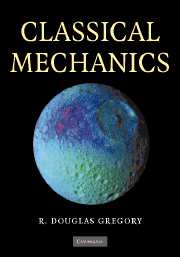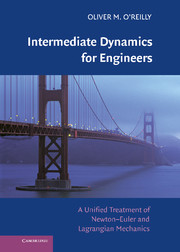Refine search
Actions for selected content:
8126 results in Fluid dynamics and solid mechanics
Preface
-
- Book:
- Mathematical Models in Contact Mechanics
- Published online:
- 05 October 2012
- Print publication:
- 13 September 2012, pp xi-xiv
-
- Chapter
- Export citation
7 - Analysis of piezoelectric contact problems
- from II - Modelling and analysis of contact problems
-
- Book:
- Mathematical Models in Contact Mechanics
- Published online:
- 05 October 2012
- Print publication:
- 13 September 2012, pp 217-250
-
- Chapter
- Export citation
Bibliographical notes
-
- Book:
- Mathematical Models in Contact Mechanics
- Published online:
- 05 October 2012
- Print publication:
- 13 September 2012, pp 251-256
-
- Chapter
- Export citation

Classical Mechanics
-
- Published online:
- 05 September 2012
- Print publication:
- 13 April 2006

Intermediate Dynamics for Engineers
- A Unified Treatment of Newton-Euler and Lagrangian Mechanics
-
- Published online:
- 05 September 2012
- Print publication:
- 04 August 2008
-
- Book
- Export citation

Principles of Turbomachinery in Air-Breathing Engines
-
- Published online:
- 05 September 2012
- Print publication:
- 31 July 2006
-
- Book
- Export citation
6 - Acoustic Wave Propagation II – Heat Release, Complex Geometry, and Mean Flow Effects
-
- Book:
- Unsteady Combustor Physics
- Published online:
- 05 October 2012
- Print publication:
- 27 August 2012, pp 154-198
-
- Chapter
- Export citation
3 - Hydrodynamic Flow Stability I: Introduction
-
- Book:
- Unsteady Combustor Physics
- Published online:
- 05 October 2012
- Print publication:
- 27 August 2012, pp 50-71
-
- Chapter
- Export citation
10 - Flame Stabilization, Flashback, Flameholding, and Blowoff
-
- Book:
- Unsteady Combustor Physics
- Published online:
- 05 October 2012
- Print publication:
- 27 August 2012, pp 293-316
-
- Chapter
- Export citation
Detailed Contents
-
- Book:
- Unsteady Combustor Physics
- Published online:
- 05 October 2012
- Print publication:
- 27 August 2012, pp vii-xii
-
- Chapter
- Export citation
Overview of the Book
-
- Book:
- Unsteady Combustor Physics
- Published online:
- 05 October 2012
- Print publication:
- 27 August 2012, pp xvii-xx
-
- Chapter
- Export citation
Index
-
- Book:
- Unsteady Combustor Physics
- Published online:
- 05 October 2012
- Print publication:
- 27 August 2012, pp 401-405
-
- Chapter
- Export citation
8 - Ignition
-
- Book:
- Unsteady Combustor Physics
- Published online:
- 05 October 2012
- Print publication:
- 27 August 2012, pp 225-246
-
- Chapter
- Export citation
Summary Contents
-
- Book:
- Unsteady Combustor Physics
- Published online:
- 05 October 2012
- Print publication:
- 27 August 2012, pp v-vi
-
- Chapter
- Export citation
4 - Hydrodynamic Flow Stability II: Common Combustor Flow Fields
-
- Book:
- Unsteady Combustor Physics
- Published online:
- 05 October 2012
- Print publication:
- 27 August 2012, pp 72-123
-
- Chapter
- Export citation
2 - Decomposition and Evolution of Disturbances
-
- Book:
- Unsteady Combustor Physics
- Published online:
- 05 October 2012
- Print publication:
- 27 August 2012, pp 17-49
-
- Chapter
- Export citation
9 - Internal Flame Processes
-
- Book:
- Unsteady Combustor Physics
- Published online:
- 05 October 2012
- Print publication:
- 27 August 2012, pp 247-292
-
- Chapter
- Export citation
12 - Forced Response II – Heat Release Dynamics
-
- Book:
- Unsteady Combustor Physics
- Published online:
- 05 October 2012
- Print publication:
- 27 August 2012, pp 364-400
-
- Chapter
- Export citation
Frontmatter
-
- Book:
- Unsteady Combustor Physics
- Published online:
- 05 October 2012
- Print publication:
- 27 August 2012, pp i-iv
-
- Chapter
- Export citation
1 - Overview and Basic Equations
-
- Book:
- Unsteady Combustor Physics
- Published online:
- 05 October 2012
- Print publication:
- 27 August 2012, pp 1-16
-
- Chapter
- Export citation
